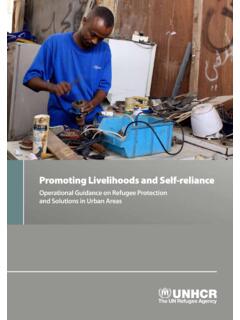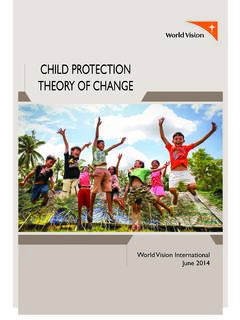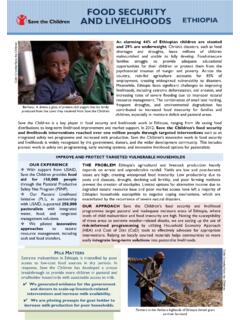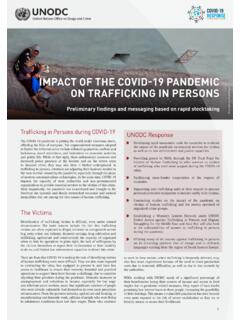Transcription of Food security & livelihoods.
1 Tdh/Ollivier Girard - Burkina FasoFood security & livelihoods . Thematic Policy 2 Tdh/Jean-Luc Marchina - IndeTerre des hommes is the leading Swiss organisation for child relief. Founded in 1960, Terre des hommes helps to build a better future for disadvantaged children and their communities, with an innovative approach and practical, sustainable solutions. Active in more than 30 countries, Tdh develops and implements field projects to allow a better daily life for over million children and their close relatives, particularly in the domains of health care and protection .
2 This engagement is financed by individual and institutional support, of which 86% flows directly into the programs of Tdh. 3 Tdh/Jean-Luc Marchina - IndeContents. List of acronyms 5 Introduction 7I. food security and livelihoods 8 Global findings 10 The fight against hunger and poverty 11 The Sustainable livelihoods conceptual framework 12II. Our intervention 14 Reasons for acting and short-term objectives 16 Synergies and target groups 17 III. Methods of intervention 20 Preview 21 Economic support and social safety nets 21 food and nutrition security 26 Training 28IV.
3 Cross-cutting elements 30 Targeting 32 Sensitivity to gender issues 33 Participatory and community-based approaches 34 Collectivist approaches versus individual support 35 Do No Harm and conflict sensitivity 35 Partnership 36 Participation in coordination mechanisms 36 Involvement with research and academic circles 37 National advocacy 37 Glossary 39 Annexes 43 Annexe 1 : Social protection 44 Annexe 2 : food security and livelihoods in emergencies 47 Annexe 3 : Project Cycle Management 51 Select bibliography 55 4 Tdh/Ollivier Girard - Burkina Faso5 Tdh/Ollivier Girard - Burkina FasoACF Action Contre la Faim [Action against Hunger]CALP Cash Learning Partnership DAC OECD Development Assistance CommitteeDFID Department for International Development (UK)DG ECHO European Community Humanitarian Aid and Civil protection OfficeDNH Do No Harm FAO food and Agriculture Organization FFS Farmer Field School FSL food security and Livelihood(s)
4 GRET Groupe Recherche Echange Technologie [Group for Research Exchange and Technology] HEA Household Economic Analysis HPN / ODI Humanitarian Practice Network / Overseas Development Institute IDS Institute of Development Studies IFAD International Fund for Agricultural DevelopmentIFPRI International food Policy Research InstituteIGA Income-generating activitiesILO International Labour Organization LRRD Linking Relief, Rehabilitation and DevelopmentMFI Microfinance Institution NGO Non-Governmental Organization OECD Organisation for Economic Cooperation and Development PCM Project Cycle Management SDC Swiss Agency for Development and Cooperation SL Sustainable livelihoods SPF Social protection Floor Tdh Terre des hommes UNICEF United Nations Children s Fund URD (Groupe)
5 Urgence R habilitation D veloppement [Emergency Rehabilitation Development] WASH Water Sanitation and HygieneWFP World food ProgrammeWHO World Health Organization List of Tdh - Sri document is the first attempt to provide a frame-work for Terre des hommes (Tdh) actions in the sec-tor of food security and livelihoods . 1 It aims to clarify the challenges as well as the ob-jectives and methods the organisation has chosen to adopt for its interventions in this sector. The document intends to provide a reference for the Department of Programmes as well as for field work-ers in our delegations around the world.
6 Its goal is to offer our staff guidance on the basic principles for identifying, designing, implementing, monitoring and evaluating our sector-specific interventions. Section I outlines the global challenges of food secu-rity and livelihoods along with the reasons prompt-ing us to take II concentrates more specifically on our ac-tion, and how the organisation perceives the short-term development of our food security and livelihoods programme and its integration in our operational framework. It highlights its functional significance and planned synergies with the key areas Tdh works in: Child protection and Maternal and Child Health III takes a closer look at our working meth-ods and the range of actions the organisation propos-es to take to achieve its programme goals.
7 This sec-tion only intends to provide an outline of our thematic actions; forthcoming practical manuals will provide more detailed IV covers the cross-cutting issues that should inform our programme interventions, such as gender sensitivity, Do No Harm, targeting practices, participa-tory and community-based approaches, advocacy and involvement in coordination mechanisms. The document is primarily targeted at an informed audience. The language may occasionally be inac-cessible to some readers; the glossary at the end has been designed to help unravel some terms that are frequently used sometimes too casually for inter-ventions in the food security and livelihoods sector.
8 This document also has three annexes: Annexe I aims to highlight the main issues and chal-lenges of social protection programmes (such as how these dovetail with universal benefits systems and the welfare state) that aim to strengthen the resil-ience of children, families and communities and con-tribute to social equity. It is not intended to regulate our actions but rather to provide an overview of the scale of the problem while also presenting the con-cept of the food security Floor. Annexe II covers sector-specific interventions in humanitarian crisis situations.
9 Indeed, the destabi-lisation of the political, social and economic fabric sometimes requires adopting ad hoc instruments to tackle increased vulnerability, albeit from a per-spective of linking humanitarian action to longer term III applies our Project Cycle Management methodology to build on several elements that are specific to the issue of food security and livelihoods . Finally, this document contains a select bibliography listing, by subject area, works that have been chosen for their capacity to summarise or clarify various topics. 1 Since this document constitutes the first point of reference for guiding our interventions in the food Securit y and livelihoods sector, it shall remain for controlled circulation and be valid for three years from the date of publication, unless the Programmes Directorate extends it validit y.
10 Tdh - Sri Lanka89 Tdh/Ollivier Girard - Burkina FasoI. food security and to FAO s most recent estimates, between 2012 and 2014, about 805 million people (in other words, approximately the population of Europe and the United States combined) suffered from chronic un-dernutrition. This represents a decrease of 100 million people over the last decade, and of 209 million people since 1992. Over the same period, the prevalence of undernutrition worldwide dropped from to and from to in developing countries. 2 The number of people in the world living below the ex-treme poverty line (USD per day and per person) 3 decreased from nearly two to less than one billion be-tween 1981 and 2012.








